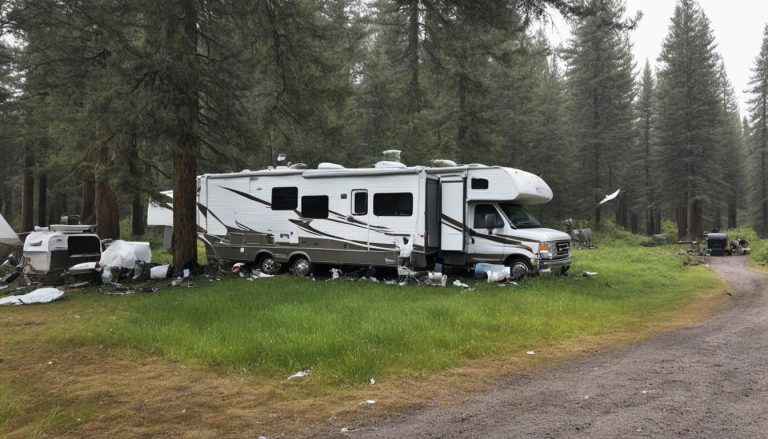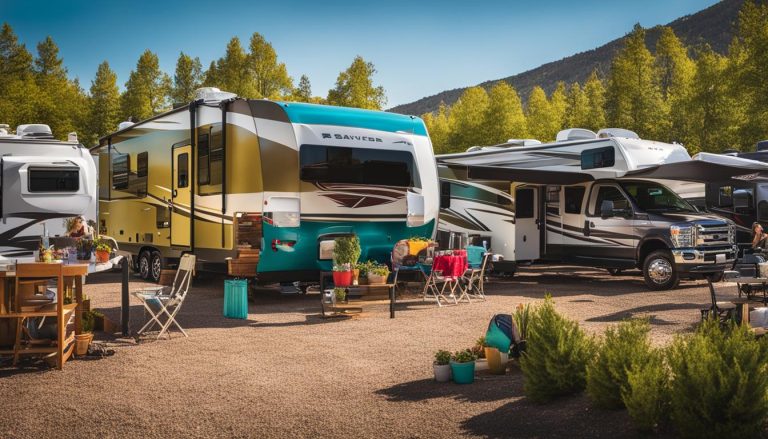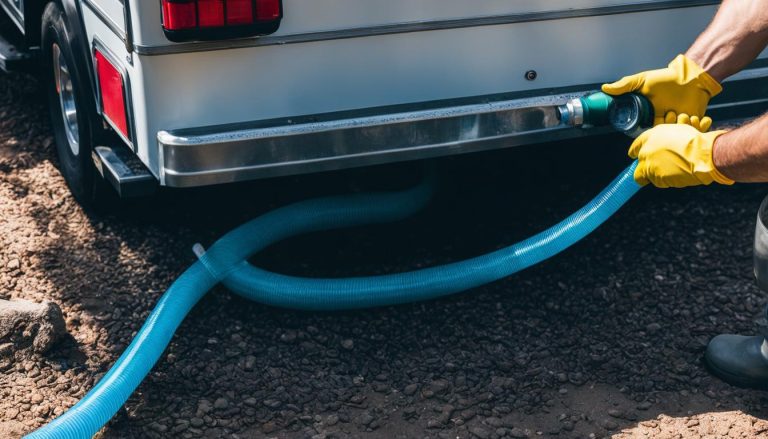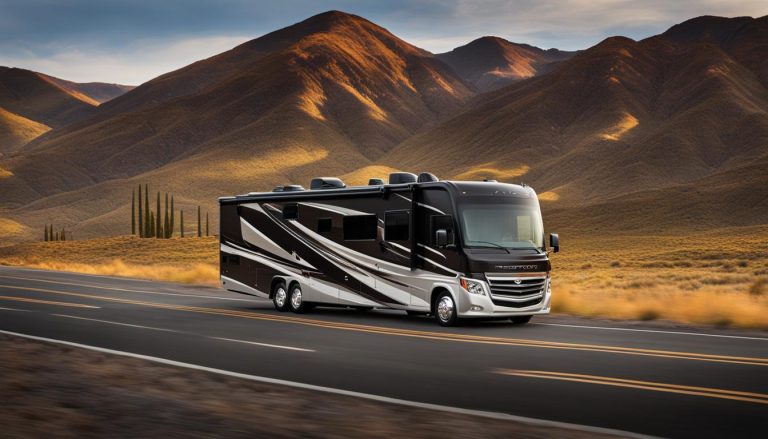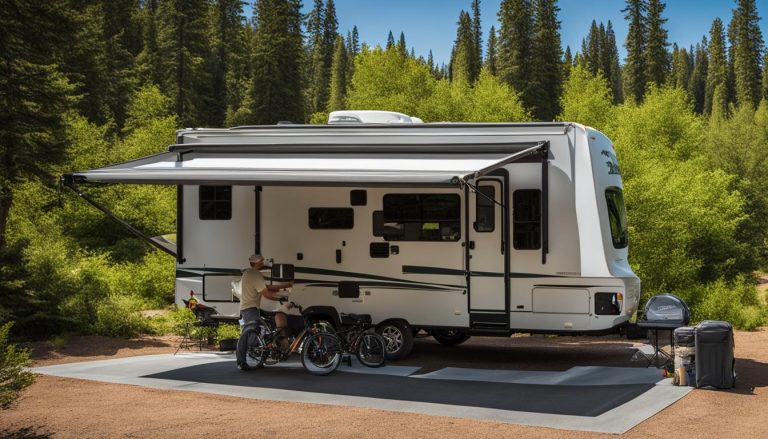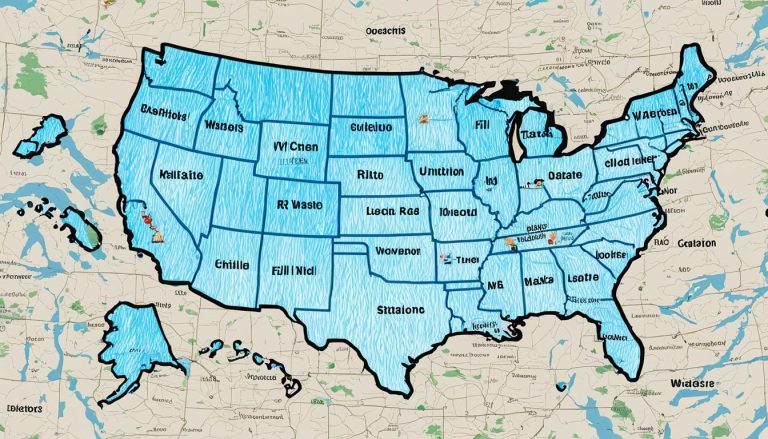Connect RV to House Sewer Easily – Quick Guide
gorvlifestyle.com and its partners may earn a commission if you purchase a product through one of our links
Setting up your RV sewer hose for connecting to a house sewer can be a simple and convenient solution for waste management. By following a few steps and using the right equipment, you can easily connect your RV to a house sewer.
Key Takeaways:
- Learn how to hook up your RV to a house sewer for convenient waste management.
- Ensure you have the right equipment, such as a quality RV sewer hose.
- Use RV sewer pipe fittings to securely connect your hoses to the house sewer.
- Be aware of the best RV sewer pipe fittings available on the market.
- Understand how to empty your RV black tank using a house sewer clean-out.
RV Sewer Hose Setup For Two Connections Overview
When setting up your RV sewer hose for connecting to a house sewer, it’s important to have the right equipment. This includes a quality RV sewer hose, such as the Thetford Titan RV sewer hose, which comes with multiple lengths and a sewer adapter. To connect multiple hoses, a Valterra Rotating Wye Adapter can be used. Additionally, using a Camco Sidewinder RV Sewer Hose Support will help to properly support the hoses.
Having a reliable RV sewer hose setup is crucial for efficient waste management and preventing any leaks or blockages. The Thetford Titan RV sewer hose is designed with durability and ease of use in mind. With its multiple lengths, you can choose the perfect size to reach the house sewer connection without straining or stretching the hose.
The sewer adapter provided with the Thetford Titan RV sewer hose ensures a secure and watertight connection to the house sewer outlet. This adapter is compatible with most standard sewer connections found in residential areas, making the setup process quick and hassle-free.
The Valterra Rotating Wye Adapter is an excellent addition to your RV sewer hose setup when you need to connect more than one hose. This adapter allows you to join two hoses together and effectively manage wastewater flow. The rotating feature of the adapter ensures flexibility and ease of use, enabling you to position the hoses in the most convenient way.
To support your RV sewer hoses properly and prevent sagging or dragging, the Camco Sidewinder RV Sewer Hose Support is an ideal solution. This support system features a sturdy and lightweight design that can accommodate various RV hose lengths. Its angled, cradle-shaped support helps to create a downward slope for efficient drainage and prevents clogs.
By investing in the right equipment, such as the Thetford Titan RV sewer hose, Valterra Rotating Wye Adapter, and Camco Sidewinder RV Sewer Hose Support, you can ensure a reliable and hassle-free connection between your RV and house sewer. This setup will make your waste management process more convenient and efficient, giving you peace of mind during your RV adventures.
How To Use RV Sewer Pipe Fittings
RV sewer pipe fittings are essential for connecting your RV sewer hose to a house sewer. These fittings come in different types, including threaded fittings and bayonet fittings. Standard fittings, elbow fittings, Y-shaped fittings, hose couplers, and rinse attachments are also available to ensure a secure and easy connection between hoses and sewer inlets.
Threaded fittings are commonly used to connect your RV sewer hose with a twist-on mechanism, providing a reliable and leak-free connection. Bayonet fittings, on the other hand, feature a more secure locking system that allows for quick and easy attachment and detachment.
Standard fittings are versatile, as they can be used to connect hoses of the same or different diameters. Elbow fittings are designed to provide a seamless transition between hoses and optimize flow. Y-shaped fittings are ideal for splitting the flow between two sewer inlets, allowing for simultaneous emptying of multiple tanks.
Hose couplers are useful when you need to extend the length of your sewer hose by connecting two separate hoses. These couplers usually feature a secure locking mechanism to ensure a tight seal. Rinse attachments, such as spray nozzles or flush valves, can be connected to the sewer pipe fittings for convenient cleaning and rinsing of the hoses and tanks.
When using RV sewer pipe fittings, it’s important to choose high-quality products that are durable and reliable. Make sure to check the compatibility of the fittings with your RV sewer hose and the sewer system you are connecting to. Follow the manufacturer’s instructions for proper installation and maintenance to ensure the longevity of your fittings and a leak-free connection.
Benefits of Using RV Sewer Pipe Fittings:
Using RV sewer pipe fittings offers several benefits, including:
- Secure and leak-free connections between hoses and sewer inlets;
- Easy installation, attachment, and detachment;
- Flexibility in connecting hoses of different sizes and angles;
- Convenient cleaning and rinsing options;
- Enhanced flow optimization to prevent clogs;
- Durable and long-lasting construction for reliable performance.
By utilizing the right RV sewer pipe fittings, you can ensure a smooth and efficient waste management system for your RV, enhancing your overall camping experience.
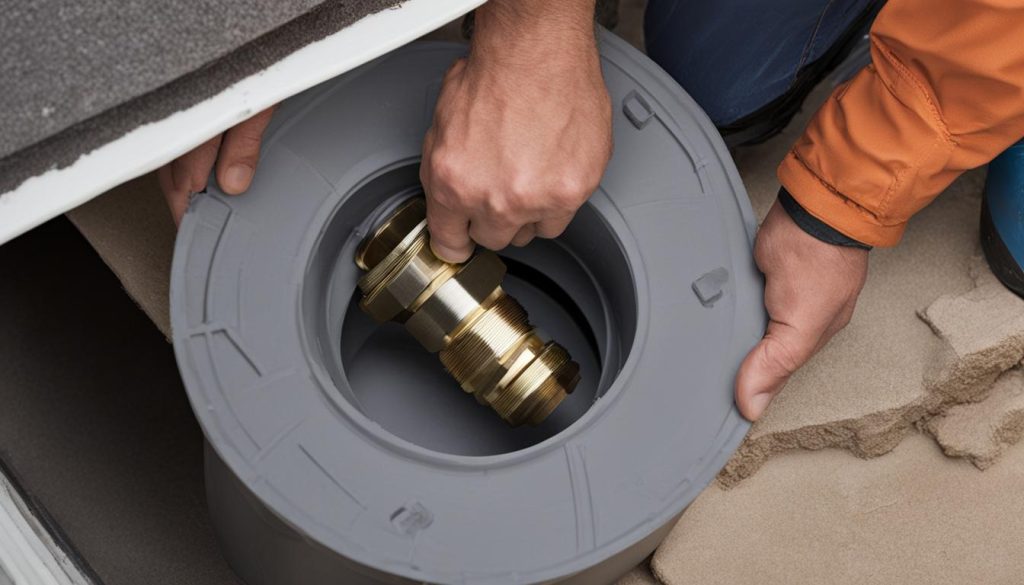
| Fitting Type | Description |
|---|---|
| Threaded Fittings | Fittings with a twist-on mechanism for secure connection |
| Bayonet Fittings | Fittings with a locking system for quick and easy attachment |
| Standard Fittings | Versatile fittings for connecting hoses of the same or different diameters |
| Elbow Fittings | Fittings for seamless transition between hoses and optimized flow |
| Y-shaped Fittings | Fittings for splitting the flow between two sewer inlets |
| Hose Couplers | Fittings for extending the length of your sewer hose with two separate hoses |
| Rinse Attachments | Attachments for cleaning and rinsing of hoses and tanks |
What Are The Best RV Sewer Pipe Fittings?
When it comes to choosing the best RV sewer pipe fittings, there are several top-rated options available on the market. These fittings play a crucial role in ensuring a secure and efficient connection between your RV sewer hose and the house sewer. Let’s take a closer look at some of the top-rated RV sewer pipe fittings:
Camco RhinoFlex Clear RV Sewer Hose Elbow With 4-in-1 Adapter
The Camco RhinoFlex Clear RV Sewer Hose Elbow with 4-in-1 Adapter is a versatile choice that offers maximum flexibility. With its 45-degree elbow design, this fitting allows for easy connection to the sewer inlet. The 4-in-1 adapter provides compatibility with various hose sizes, making it convenient for use with different RV sewer hose setups.
Valterra 45-Degree HydroFlush Attachment
The Valterra 45-Degree HydroFlush Attachment is an excellent option for easy cleaning of wastewater tanks. This fitting features a 45-degree angle, allowing for efficient flushing of your RV’s black and gray water tanks. By attaching it to your sewer hose, you can thoroughly clean your tanks, ensuring optimal hygiene and performance.
Camco 39319 Flexible 3-in-1 Sewer Hose Seal With RhinoExtreme Hose
For those looking for flexibility in connecting hoses at different angles, the Camco 39319 Flexible 3-in-1 Sewer Hose Seal with RhinoExtreme Hose is a fantastic choice. This fitting offers a secure and leak-proof connection, thanks to its durable construction and flexible design. It allows for easy rotation and adjustment, ensuring a tight and reliable connection between hoses.
Camco RhinoFLEX RV Wye Sewer Hose Fitting
The Camco RhinoFLEX RV Wye Sewer Hose Fitting is ideal for RVers who want to connect multiple tanks to a single hose. This fitting allows you to split the flow from your RV’s black and gray water tanks, creating a convenient configuration. By using the RhinoFLEX RV Wye Sewer Hose Fitting, you can efficiently manage the waste flow and simplify your sewer system setup.
Camco Easy Slip Internal Hose Coupler With Slip-Lock Rings
When you need to connect two separate hoses for additional length, the Camco Easy Slip Internal Hose Coupler with Slip-Lock Rings is a perfect solution. This durable and secure coupler enables a tight connection between hoses without the risk of leakage. With its slip-lock rings, it provides a hassle-free and reliable connection, ensuring a smooth and efficient waste transfer.
These are just a few examples of the best RV sewer pipe fittings available on the market. Each of these fittings offers unique features and benefits, catering to different needs and preferences. Whether you’re looking for versatility, easy cleaning, flexibility, or multiple connections, there’s a fitting that suits your requirements.

How To Empty Your RV Black Tank In A House Sewer Clean-Out
If you need to empty your RV black tank and are staying at a residence with a house sewer clean-out, you can use this method for dumping your waste. To do so, you will need to locate the house sewer clean-out, which is usually a 4-inch PVC pipe with a white plastic screw-in cap.
To locate the house sewer clean-out:
- Look for a 4-inch PVC pipe in the vicinity of the house
- The clean-out is usually located near the foundation or the exterior wall of the house
- It may have a white plastic screw-in cap that can be unscrewed
- Ensure that you have permission from the homeowner to use their sewer clean-out
To empty your RV black tank using the house sewer clean-out:
- Carefully unscrew the cap from the house sewer clean-out
- Connect your RV’s sewer hose to the clean-out using a suitable adapter
- Ensure a secure connection to prevent any leaks
- Open the black tank valve to allow the waste to flow into the house sewer
- Monitor the process and ensure that the tank is fully emptied
It’s important to note that using a house sewer connection for RV dumping may be illegal in some areas, so it’s essential to check local laws and restrictions.
Using a house sewer connection for RV dumping may be illegal in some areas. Always check local laws and restrictions before proceeding.
Additionally, septic systems have limitations and may not be able to handle large amounts of water. It’s important to be mindful of your water usage and avoid dumping excessive amounts of water into septic tanks or drainfields.
Be mindful of septic system limitations and avoid overloading the system with excessive water.
Using a House Sewer Connection vs. Dump Stations
Using a house sewer connection for RV dumping can offer convenience and ease of use. However, it’s important to consider the limitations and legalities involved. Here are some points to keep in mind:
- A house sewer connection allows you to dump your RV black tank at the location where you are staying, eliminating the need to travel to dump stations.
- Connecting to a house sewer clean-out is a straightforward process that requires minimal setup.
- Using a house sewer connection may be more cost-effective compared to paying for dump station fees.
- However, some areas have regulations that prohibit the use of house sewer connections for RV dumping.
- Septic systems may have limitations on their capacity to handle large amounts of wastewater, so it’s essential to be mindful of your water usage.
Ultimately, the decision to use a house sewer connection or a dump station for RV dumping depends on the specific circumstances and regulations in your area.
Benefits of Connecting RV to House Sewer
Connecting your RV to a house sewer offers numerous advantages that can enhance your overall RV experience. By making this connection, you can enjoy convenient waste management, cost savings, easy access to sewer facilities, and flexible dump locations.
“Connecting your RV to a house sewer can greatly simplify your waste disposal process.”
Convenient Waste Management
One of the key benefits of connecting your RV to a house sewer is the convenience it provides for waste management. Instead of having to travel to dump stations and deal with crowded or dirty facilities, you can simply connect your RV directly to a house sewer. This not only saves you time but also eliminates the hassle of finding suitable dump stations along your route.
Cost Savings
Connecting your RV to a house sewer can also lead to cost savings. Many dump stations charge fees for waste disposal, and these costs can add up over time. By avoiding the need to visit dump stations, you can save money on these fees, allowing you to allocate your budget for other travel expenses or leisure activities.
Easy Access to Sewer
Having a house sewer connection for your RV gives you easy access to sewer facilities. With the connection in place, you don’t have to worry about maneuvering your RV into specific positions to reach dump stations or dealing with varying outlet heights. The sewer connection at the house is readily accessible, ensuring a smooth and efficient waste disposal process.
Flexibility in Dump Location
Connecting your RV to a house sewer also offers flexibility in choosing a dump location. Unlike traditional dump stations that require you to follow a predefined route, connecting to a house sewer allows you to choose where you want to dump your waste. As long as the house has a sewer clean-out, you can easily connect your RV and dispose of your waste without limitations.
By leveraging the benefits of connecting your RV to a house sewer, you can simplify your waste management, save money on dump station fees, easily access sewer facilities, and enjoy more flexibility in choosing dump locations.
Take a look at the table below for a quick overview of the advantages of connecting your RV to a house sewer:
| Benefits | Description |
|---|---|
| Convenient waste management | Eliminates the need to travel to dump stations |
| Cost savings | Avoids dump station fees |
| Easy access to sewer | Readily accessible sewer facilities |
| Flexibility in dump location | Choice of dump location based on house sewer clean-out |
Connecting your RV to a house sewer provides a range of benefits that enhance your waste management experience. It simplifies the process, saves costs, ensures easy access to sewer facilities, and offers flexibility in choosing dump locations.
Conclusion
Connecting your RV to a house sewer can be a practical and efficient way to manage your waste while staying at a residence. By following the proper steps and using the appropriate equipment, you can easily connect your RV to a house sewer and streamline your waste management process. This allows you to have a convenient solution for handling your waste without the need to travel to dump stations.
However, it’s crucial to be aware of local laws and restrictions regarding RV dumping. Different areas may have specific regulations in place, so it’s important to check before connecting your RV to a house sewer. Additionally, it’s essential to respect the limitations of septic systems. Septic tanks may have capacity restrictions and may not be able to handle large amounts of water coming from an RV. Being mindful of usage and avoiding dumping into septic systems or drainfields is important to prevent any issues.
Always remember to practice proper waste disposal. This includes using appropriate sewer pipe fittings and ensuring a secure connection between your RV sewer hose and the house sewer. Consider alternatives, such as using designated dump stations, when necessary. By following these guidelines, you can effectively manage your waste while avoiding any potential legal or environmental concerns.
FAQ
How do I connect my RV to a house sewer?
To connect your RV to a house sewer, you will need the right equipment, including a quality RV sewer hose, sewer pipe fittings, and adapters. Locate the house sewer clean-out, unscrew the cap, and connect your RV hose to the clean-out using a hose. Dump your black tank contents. Always check local laws and restrictions before using a house sewer connection for RV dumping.
What equipment do I need to set up my RV sewer hose for connecting to a house sewer?
To set up your RV sewer hose for connecting to a house sewer, you will need a quality RV sewer hose, such as the Thetford Titan RV sewer hose, a Valterra Rotating Wye Adapter for multiple hose connections, and a Camco Sidewinder RV Sewer Hose Support for proper hose support.
What types of RV sewer pipe fittings should I use for connecting my RV sewer hose to a house sewer?
There are different types of RV sewer pipe fittings you can use, including threaded fittings, bayonet fittings, standard fittings, elbow fittings, Y-shaped fittings, hose couplers, and rinse attachments. These fittings ensure a secure and easy connection between your RV sewer hose and the house sewer inlet.
What are some top-rated RV sewer pipe fittings available on the market?
Some top-rated RV sewer pipe fittings include the Camco RhinoFlex Clear RV Sewer Hose Elbow with 4-in-1 Adapter, the Valterra 45-Degree HydroFlush Attachment for easy tank cleaning, the Camco 39319 Flexible 3-in-1 Sewer Hose Seal with RhinoExtreme Hose for flexible hose connections, the Camco RhinoFLEX RV Wye Sewer Hose Fitting for connecting multiple tanks to a single hose, and the Camco Easy Slip Internal Hose Coupler with Slip-Lock Rings for connecting separate hoses for additional length.
How do I empty my RV black tank in a house sewer clean-out?
To empty your RV black tank in a house sewer clean-out, locate the clean-out, which is usually a 4-inch PVC pipe with a white plastic screw-in cap. Carefully unscrew the cap, connect your RV to the clean-out using a hose, and then dump the black tank contents. Always check local laws and restrictions as using a house sewer connection for RV dumping may be illegal in some areas.
What are the benefits of connecting my RV to a house sewer?
Connecting your RV to a house sewer offers several benefits. It provides convenient waste management, eliminating the need to travel to dump stations. It can result in cost savings as you won’t need to pay for dump station fees. Connecting to a house sewer also offers easy access to a sewer connection, allowing for hassle-free waste disposal. Additionally, connecting to a house sewer provides flexibility in choosing a dump location, as you can easily connect wherever the house sewer clean-out is located.

